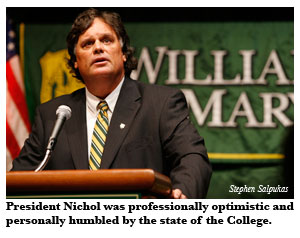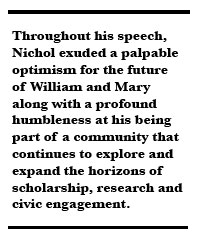Nichol on State of the College: Five pillars unite W&M
 Increased
support for growing research efforts, a commitment to fairly compensate
staff members and a continued drive to open the institution’s doors to
persons representing diverse ethnicities and circumstances are among
the challenges to be faced as the College continues with its commitment
to being “great and public,” President Gene Nichol told more than 350
people attending the inaugural State of the College address on Jan. 25.
Increased
support for growing research efforts, a commitment to fairly compensate
staff members and a continued drive to open the institution’s doors to
persons representing diverse ethnicities and circumstances are among
the challenges to be faced as the College continues with its commitment
to being “great and public,” President Gene Nichol told more than 350
people attending the inaugural State of the College address on Jan. 25.
Introduced in flattering terms by Student Assembly president Ryan Scofield, who remarked that Nichol had “redefined” the position of president of the College through his concern for students and his participation in their activities, and affirmed with sustained applause from an obviously supportive community, Nichol proceeded to recite a heady list of accomplishments by College personnel and to elaborate upon the opportunities that are ahead.
Among those opportunities, he said, was the chance to build upon recent conversations resulting from his highly publicized October decision concerning display of the Wren Chapel cross as a way of instituting an expanded dialogue to inform both the College and the broader academic community on issues related to faith in the public sphere. To that end, he announced the formation of the President’s Committee on Religion and Faith at a Public University, and he named James Livingston, the Walter G. Mason Professor Emeritus of Religion at the College, and Alan J. Meese, the Ball Professor of Law at the Marshall-Wythe School of Law, as co-chairs.
Nichol said that questions raised by his cross decision included whether the separation of church and state at public universities assumes “a bleaching of the importance and influence of faith and religious thought from discourse” and whether a public university could “honor and celebrate a particular religious heritage while remaining equally welcoming to those of all faiths.”
“Given the challenge of these questions, the controversy that has ensued about my decision, and given the fact that this is a great university, it is my hope to probe and explore these issues in the most thoughtful way possible,” Nichol said. He said the committee would report back to him by the end of the semester.
 Throughout his speech, Nichol exuded a palpable optimism for the future
of William and Mary along with a profound humbleness at his being part
of a community that continues to explore and expand the horizons of
scholarship, research and civic engagement.
Throughout his speech, Nichol exuded a palpable optimism for the future
of William and Mary along with a profound humbleness at his being part
of a community that continues to explore and expand the horizons of
scholarship, research and civic engagement.
Specifically he cited a recent Kiplinger’s report naming the College as the third-best value in American higher education, another report indicating that William and Mary ranks sixth among comparable institutions in the number of alumni who serve in the Peace Corps and an assessment by the National Collegiate Athletic Association indicating that William and Mary athletes achieved the fifth-highest academic performance ranking in the nation as he reflected upon indicators of the university’s stature. He also marvelled at the fact that “volunteers, friends, alumni committees, university officials and development professionals brought in, amazingly, a record over $26 million in the final quarter of 2006, assuring, through private generosity, that the College will have every opportunity to meet its charge of being great and public.”
Nichol also referenced meetings involving more than 25,000 members of the extended William and Mary family during the past 18 months that had convinced him that the community is “of one mind” about the values and mission of the university. He summarized that consensus in terms of five pillars: (1) that “our intimate, supportive, rigorous, engaged, dynamic, residential form of liberal-arts education is … the strongest, most affecting and likely the most pragmatic tool the academy has to offer”; (2) that “academic excellence, intellectual achievement and the highest standards of performance, imagination and creativity inform all that we do”; (3) that “our programs are premised on a culture that promoted deep and sustained faculty involvement in the lives, development and work of our students”; (4) that “our high standards of instruction are leavened by a foundational and sustaining commitment to research”; and (5) that, as the campuswide committee on diversity asserted last year, the College “strives to be a place where people of all backgrounds feel at home, where diversity is actively embraced and where each individual takes responsibility for upholding the dignity of all members of the community.”
Elaborating upon that final pillar, Nichol expressed his delight that the College’s Class of 2010 was the most diverse in decades—almost 25 percent were “students of color,” he said—and that nearly 90 students had been brought in under the Gateway initiative, which offers an opportunity for a debt-free education to deserving students from low-income families in Virginia.
“The challenge of economic access remains a daunting one—for us and for many of the most accomplished universities in the nation,” Nichol said. He pledged during the next six years to seek to double the number of Gateway-eligible students at the College and to, in partnership with the commonwealth, extend financial-aid packages beyond the poorest students to others who face “potent challenges resulting from the increasing costs of higher education.”
In concluding his State of the College address, Nichol said, “I came to Williamsburg 18 months ago drawn, in no small measure, by the remarkable history of the College. No institution is so intimately tied to the marvels, possibilities and contradictions of the American story.” In the intervening months, he admitted that his respect for that history has been superseded by his admiration for those who carry it forward, “pressing themselves and their boundaries ever more fully” while realizing that “the price of greatness is, indeed, responsibility.”
“Together we have much to do,” Nichol said. “I came believing in a College. I work each day believing, as well, in you.”
 Skip to main content
Skip to main content
